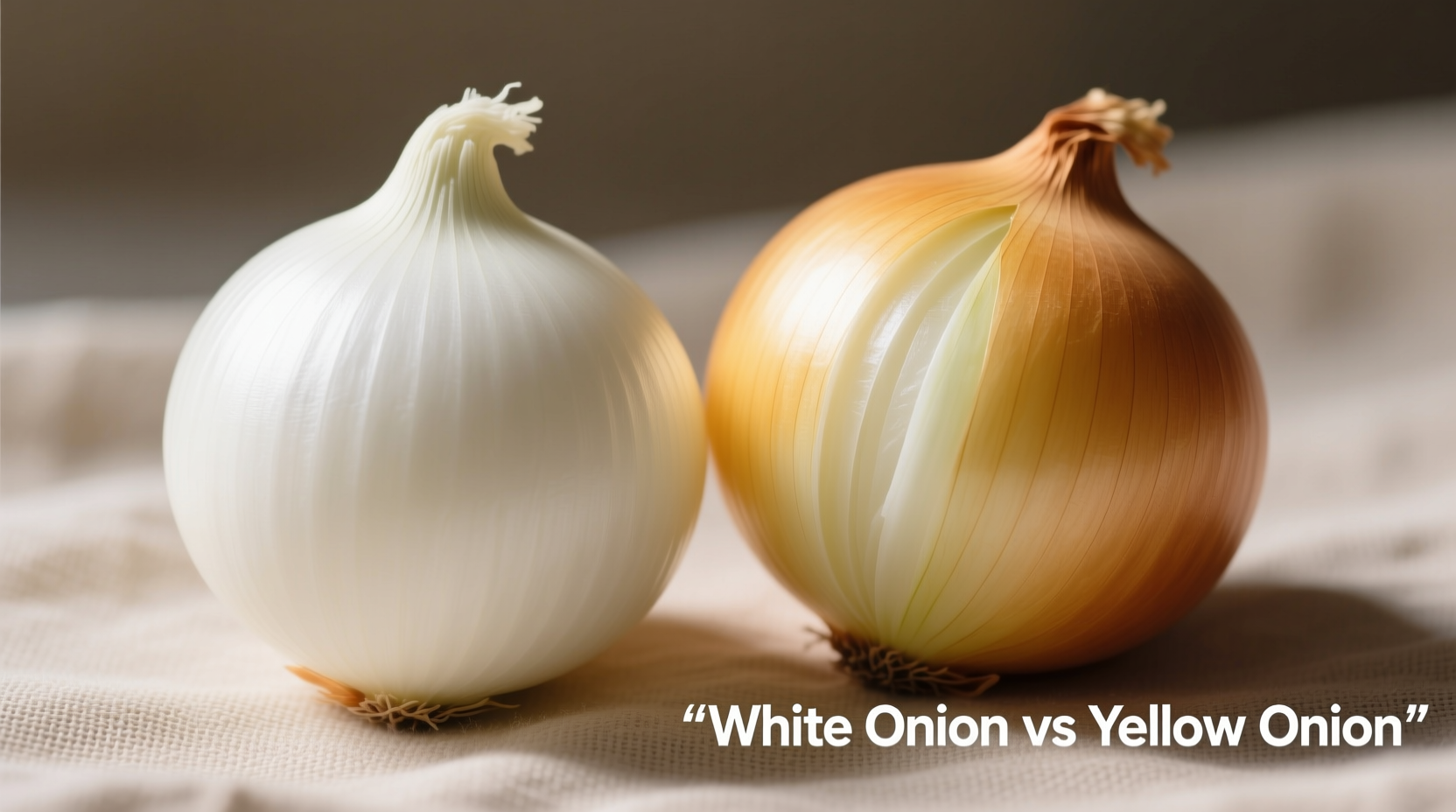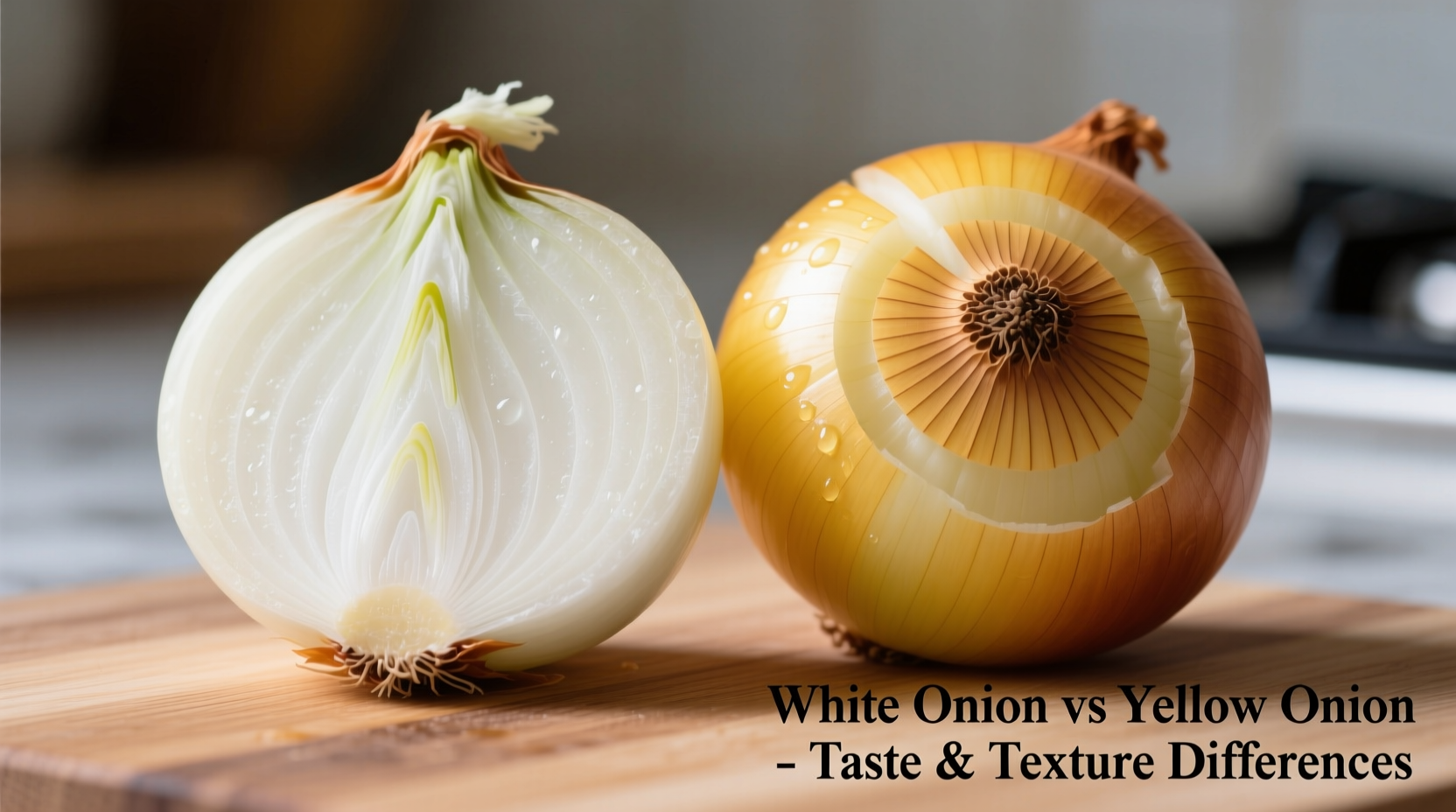White onions offer a sharper, more pungent flavor with higher water content, making them ideal for fresh salsas and ceviche, while yellow onions provide a richer, sweeter taste when cooked due to higher sugar content, perfect for caramelizing, roasting, and most cooked dishes. The key difference lies in their sulfur compounds and sugar levels, which directly impact their culinary applications.
Ever reached for an onion in your kitchen only to wonder which variety would work best for your recipe? Understanding the difference between white and yellow onion varieties isn't just culinary trivia—it directly impacts the flavor, texture, and success of your dishes. As a professional chef with years of experience, I've seen how choosing the right onion can transform an ordinary meal into something extraordinary.
| Characteristic | White Onion | Yellow Onion |
|---|---|---|
| Outer Skin | Pale white to light tan | Brownish-yellow, papery |
| Flavor Profile | Sharper, more pungent, slightly hotter | Milder raw, sweeter when cooked |
| Sugar Content | Lower (4-5%) | Higher (8-12%) |
| Water Content | Higher (90%) | Lower (87%) |
| Best Culinary Uses | Fresh applications: salsas, guacamole, ceviche | Cooked dishes: caramelizing, roasting, soups, stews |
| Shelf Life | 2-3 weeks refrigerated | 1-2 months in cool, dark place |
Flavor Chemistry: Why the Difference Matters in Your Cooking
The difference between white and yellow onion primarily stems from their varying sulfur compounds and sugar content. According to research from the University of California, Davis Department of Plant Sciences, yellow onions contain higher concentrations of fructose and sucrose, which caramelize beautifully when exposed to heat, creating that rich, complex sweetness essential in French onion soup and roasted vegetables (UC Davis Agricultural Extension).
White onions, meanwhile, have higher levels of volatile sulfur compounds that deliver that characteristic sharp bite. This makes them perfect when you want onion flavor to stand out in raw applications without mellowing during cooking. Professional chefs often reach for white onions in Mexican cuisine specifically because their flavor remains vibrant in fresh preparations.

When to Choose White Onions: Fresh Applications
White onions shine in dishes where you want pronounced onion flavor without cooking:
- Mexican and Latin American cuisine: Essential for authentic pico de gallo, fresh salsas, and guacamole where their crisp texture and sharp flavor complement spicy ingredients
- Ceviche and seafood dishes: Their higher water content helps "cook" raw fish through acidulation without overwhelming delicate seafood flavors
- Quick-pickled onions: Maintain better texture and deliver cleaner onion flavor in vinegar-based pickles
- Raw salads: Provide noticeable onion presence without the brown discoloration that sometimes occurs with yellow onions
Food science research from the Journal of Food Composition and Analysis confirms that white onions retain more of their volatile compounds when raw, which explains why they deliver that distinctive "bite" in fresh preparations (Journal of Food Composition and Analysis).
When Yellow Onions Reign Supreme: Cooking Applications
Yellow onions transform dramatically when heat is applied, making them the workhorse of most professional kitchens:
- Caramelizing: Their higher sugar content (8-12% versus 4-5% in white onions) creates deeper, richer caramelization essential for French onion soup and savory tarts
- Stocks and sauces: Break down more completely, creating a smoother base for gravies, soups, and braises
- Roasted vegetables: Complement root vegetables beautifully, developing complex sweetness without overpowering other ingredients
- Onion rings: Produce a better texture when fried due to their lower water content
According to the USDA Agricultural Research Service, yellow onions contain more quercetin—a flavonoid antioxidant—than white varieties, which contributes to their superior browning characteristics during cooking (USDA Flavonoid Database).
Storage Differences You Need to Know
Proper storage significantly impacts how long each onion variety maintains quality:
- Yellow onions: Store for 1-2 months in a cool, dark, well-ventilated place (55-60°F/13-16°C). Their thicker, drier skin provides better protection against moisture loss.
- White onions: More perishable—last only 2-3 weeks refrigerated in a mesh bag. Their thinner skin and higher water content make them more susceptible to mold and sprouting.
Never store either variety in plastic bags, which trap moisture and accelerate spoilage. The National Onion Association confirms that proper storage conditions can extend yellow onion shelf life by up to 50% compared to improper storage (National Onion Association Storage Guidelines).
Can You Substitute One for the Other?
Understanding the difference between white and yellow onion helps determine when substitutions work:
- Substitute yellow for white: Only in cooked applications, but expect slightly sweeter results. Never substitute in fresh salsas or ceviche where white onion's sharper flavor is essential.
- Substitute white for yellow: Possible in raw applications, but white onions lack the depth yellow onions develop when cooked. You'll miss out on the rich caramelized flavor in dishes like French onion soup.
- Best compromise: Use sweet onions (Vidalia, Walla Walla) when you need a middle ground—milder than yellow but with better cooking properties than white onions.
Common Mistakes to Avoid
Even experienced cooks make these errors when handling different onion varieties:
- Using yellow onions in fresh salsa: They become overly pungent and develop an unpleasant brownish tint as they sit.
- Cooking white onions too long: Their higher water content causes them to break down faster, resulting in mushy texture.
- Storing white onions at room temperature: They spoil much faster than yellow onions—always refrigerate white varieties.
- Not adjusting cooking times: White onions require less cooking time to achieve the same level of softness as yellow onions.
Practical Takeaways for Your Next Meal
Now that you understand the difference between white and yellow onion varieties, here's how to apply this knowledge immediately:
- For tonight's taco night: Reach for white onions in your fresh salsa and yellow onions in your taco meat seasoning
- When meal prepping: Store yellow onions in your pantry but keep white onions in the refrigerator
- For Sunday roasting: Choose yellow onions to caramelize alongside your root vegetables
- When making quick pickles: White onions maintain better texture and deliver cleaner flavor
Remember that the difference between white and yellow onion isn't about which is "better"—it's about selecting the right tool for your culinary task. By matching the onion variety to your specific application, you'll consistently achieve more professional results in your home cooking.











 浙公网安备
33010002000092号
浙公网安备
33010002000092号 浙B2-20120091-4
浙B2-20120091-4